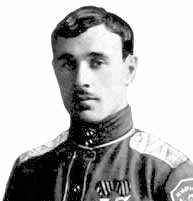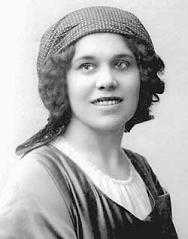Nikolai Skoblin

Nikolai Skoblin (Russian: Николай Владимирович Скоблин) (1892–1938?) was a general in the White Russian army, a member of the expatriate Russian All-Military Union (ROVS), and Soviet double agent who acted as a courier between Soviet and Nazi secret police organizations, NKVD and Gestapo.[1] He was husband to the singer Nadezhda Plevitskaya.
Early Life and Russian Civil War
Skoblin was a cavalry officer in the Kornilov Division of the White Russian Army during the Russian Civil War, 1918–1920. He was known for both his bravery and cruelty. Red soldiers captured by Skoblin's men were hanged or shot on the spot. It is said he met his wife, Plevitskaya during the war. The romantic version is that Skoblin captured his wife during a raid against the Red Army. She was Nadezhda Plevitskaya, a committed Bolshevik considered to be a great beauty, who had been traveling the front singing and entertaining Red Army troops. Plevitkskaya used her considerable charms to seduce Skoblin and escape the gallows. Through her influence, Skoblin became a Bolshevik intelligence agent for the Cheka and later for the Soviet Union's NKVD.
Life as Soviet Agent
Skoblin and his wife moved to Paris at the end of the Civil War. To outward appearances he was an anticommunist White émigré. Skoblin soon became a leader in a White counterrevolutionary organization dedicated to overthrowing the Soviet government, the Russian All-Military Union (in Russian, Русский Обще Воинский Союз, or ROVS). The ROVS, a collection of former Tsarist officers, constantly planned the fall of Joseph Stalin's government and the unlikely restoration of the Russian monarchy while engaged in petty rivalries and subterfuges. Skoblin penetrated the highest level in this group, becoming the intimate of General Evgenii Miller, its leader. It is a testament to Skoblin's skill as an informer and intriguer that he would remain Miller's confidant despite repeated warnings that he was a double-agent.
A series of articles published in the White émigré newspaper The Latest News (Posledniye Novosti) in February 1935 accused Skoblin of being a Soviet agent. The source of this information was a former member of the Kornilov Division, Lieutenant Colonel Magdenko, who had been recruited to work for Soviet Military Intelligence (GRU) in Berlin. Skoblin insisted upon having his case reviewed by a ROVS court of honor. Lacking any evidence other than hearsay, the court of honor duly exonerated Skoblin.
In the labyrinthine affair which preceded the arrest and execution of the Soviet Marshal Mikhail Tukhachevsky, Skoblin is alleged to have played the role of a triple-agent, working for the Russian white counterrevolutinaries (ROVS), Stalin's secret police (NKVD), and the German Sicherheitsdienst (SD). A review of Soviet archives after the fall of the Soviet Union established without doubt that Skoblin was in the employ of the NKVD.[2]
At the behest of the NKVD, Skoblin began a whisper campaign to slander Tukhachevsky. He informed Reinhard Heydrich, the chief of the Gestapo and SD, that Stalin believed Tuchachevsky was planning a coup d'État with the help of the Wehrmacht. Skoblin's deputy, Nikolai Alekseyev, simultaneously revealed this information to French intelligence, the Deuxième Bureau. Heydrich saw an opportunity to implicate both the Wehrmacht and the Soviet Red Army in a treasonous plot. Heydrich's aide, Walter Schellenberg, claims that Heyrich brought Skoblin's information to Hitler in the beginning of 1937. Confronted with a choice, Hitler decided to back Stalin instead of Tukhachevsky and agreed with Himmler and Heydrich to create a forgery. The Abwehr retained in their files numerous documents written by Tukhachevsky and other Red Army commanders in the 1920s when they had been allies with the Wermacht. The documents were needed for the forgery but Hitler did not want the German Army Staff to know of the plot. Heydrich staged a burglary of Abwehr headquarters and stole the documents. The Gestapo used the harmless documents to forge new ones establishing the guilt of Tukhachevsky and other Red Army commanders. Depending upon the source, the dossier thus produced was either "sold" to the NKVD or passed to Stalin through several third-party sources, including Edvard Beneš.[3] The dossier was not introduced at Tukhachevsky's trial on 11 June 1937, known as the Case of Trotskyist Anti-Soviet Military Organization, and a copy of the "red folder" has never been found. It was not needed. The defendants had already pleaded guilty.

Judging by events which followed, it is possible that Skoblin's reward from the NKVD for his role in Tukhachevsky affair was the leadership of the ROVS. On 22 September 1937 Skoblin led the former White General and ROVS leader Evgenii Miller to a meeting with two German Abwehr agents to discuss the beginning of a secret collaboration between the ROVS and Admiral Wilhelm Canaris.
In reality, the agents were not Germans, but rather operatives of the Soviet NKVD. They drugged Miller, smuggled him aboard a Soviet ship in Le Havre, and carried him back to Moscow, where he was tortured and finally executed on 11 May 1939. (Copies of letters written by Miller while he was imprisoned in Moscow are in the Dimitri Volkogonov papers at the Library of Congress.)
However, Skoblin's ambition to become the leader of the ROVS was thwarted. Miller left behind a note to be opened if he failed to return from the meeting. Skoblin had not counted upon Miller's foresight and, with his cover blown, he fled to the Soviet embassy in Paris. The French police launched a manhunt, but Skoblin had vanished.
Death
There are several accounts of Skoblin's death, all of them secondhand. Pavel Sudoplatov alleges that Skoblin escaped to Spain and died in republican-held Barcelona during a German bombing raid.[4] In Deadly Illusions (1993) by John Costello and Oleg Tsarev, the authors suggest that an NKVD General Alexander Orlov, smuggled Skoblin into civil war-ridden Spain by airplane and disposed of him in a Republican front area, keeping his ring to use in a later blackmail scheme. Victor Alexandrov speculates in The Tuchachevsky Affair (1963) that Skoblin was poisoned aboard a Soviet vessel, the Kuban, bound from Spain to Odessa (Ukrainian SSR, Soviet Union), and his skeleton ultimately ended up in a Soviet anatomical laboratory. Alexander Orlov in his own memoir, The March of Time (2004), writes that the NKVD compelled Skoblin to write undated love letters to Plevitskaya, which were used to buy her silence, and then smuggled him aboard a Soviet cargo vessel bound for Leningrad. Orlov ends his story in the Baltic Sea, leaving it to the reader to guess Skoblin's fate.
Nadezhda Plevitskaya's fate is well-known. She was put on trial as an accomplice to the kidnapping and murder of White émigré General Miller. At the time, the French government had been sheltering both Red and White refugees from the Soviet Union. The French Government had become enraged by near-daily NKVD attempts to kidnap and murder Russian political refugees in France. At her trial, Plevitskaya insisted that the couple was an unwitting accomplice to Miller's kidnapping, and that Skoblin had been murdered by the NKVD as well. However, ample evidence found at her apartment proved her involvement and work as an operative for the NKVD. Convicted on 15 December 1938, Plevitskaya was sentenced to the unusually harsh penalty of twenty years' hard labor. She died, aged fifty-six, in Rennes prison of a heart ailment on 1 October 1940, three months after the German Wehrmacht captured the city.
In Media
Skoblin's and Plevitskaya's story was fictionalized by Vladimir Nabokov, who had known Plevitskaya in Berlin, in his first English language story, "The Assistant Producer", in January 1943. It was also the basis of the French movie Triple Agent (2004) directed by Éric Rohmer. The Miller abduction and the Skoblin's relationship with Max Eitingon was the subject of a rancorous squabble between Stephen Schwartz and Theodore Draper in the pages of the New York Review of Books in April 1988.
In addition, the kidnapping of General Miller is also fictionalized in Nikita Mikhalkov's award-winning film Burnt by the Sun. In the film the character known as "Mitya" (Oleg Menshikov) is a former White Army officer turned NKVD agent. Posing as a pianist in Paris, Mitya is described as having delivered five White Generals to the NKVD. All are described as having been kidnapped, returned to Moscow, and shot without trial. One of the Generals is given the name "Weiner."
Notes
- ↑ Schwartz, Stephen. (January 24, 1988). "Intellectuals and Assassins - Annals of Stalin's Killerati". New York: New York Times. Retrieved August 6, 2012.
- ↑ Lukes, Igor, Czechoslovakia Between Stalin and Hitler: The Diplomacy of Edvard Beneš in the 1930s, Oxford University Press (1996), ISBN 0-19-510267-3, 978-0-19-510267-3, p. 95
- ↑ Lukes, Igor, Czechoslovakia Between Stalin and Hitler: The Diplomacy of Edvard Beneš in the 1930s, Oxford University Press (1996), ISBN 0-19-510267-3, 978-0-19-510267-3, p. 95
- ↑ Pavel Sudoplatov, (1994), Special Tasks, page 37.
References
- Victor Alexandrov, The Tukhachevsky Affair, Prentice-Hall, 1963. ASIN B0006D5JSY
- John Costello and Oleg Tsarev, Deadly Illusions, Crown, 1993 ISBN 0-517-58850-1
- Wilhelm Hoettl, The Secret Front, Frederick A. Praeger, 1954 ASIN B0007EFR8Y ; Enigma Books (September 1, 2003) ISBN 1-929631-07-3
- Igor Lukes, Czechoslovakia Between Stalin and Hitler, Oxford University Press, 1996 ISBN 0-19-510267-3
- Walter Krivitsky, In Stalin's Secret Service, Enigma Books, 2000 ISBN 1-929631-03-0
- Alexander Orlov, The March of Time, St. Ermins Press, 2004. ISBN 1-903608-05-8
- Walter Schellenberg, The Labyrinth, Harper and Bros, 1956.
- Pavel Sudoplatov, Special Tasks, Little, Brown and Company, 1994. ISBN 0-316-82115-2
- Ally Hauptmann-Gurski, La Plevitskaya, Author's Publication, 2011 edition ISBN 978-1456553876 (2006 ISBN 978-0-9757372-4-8 out of print)
- Photos, Biography in Russian
|